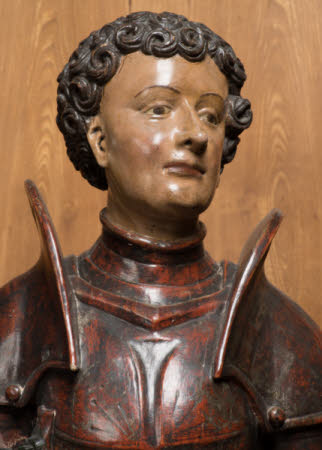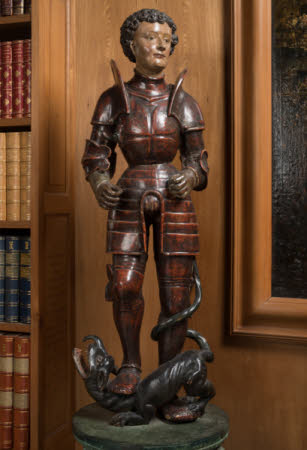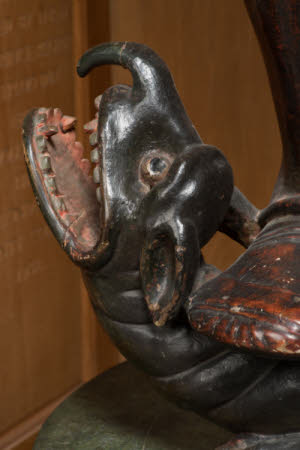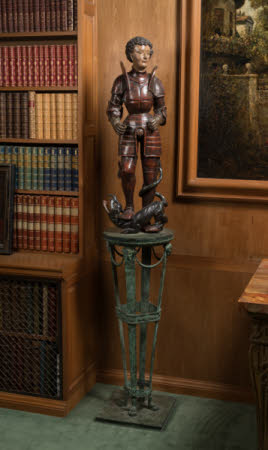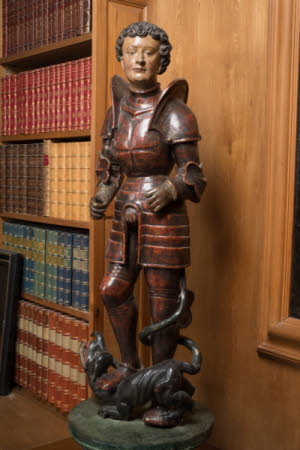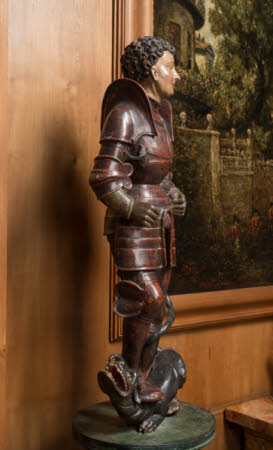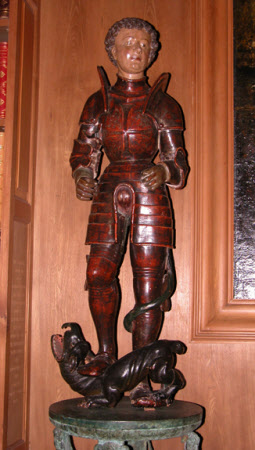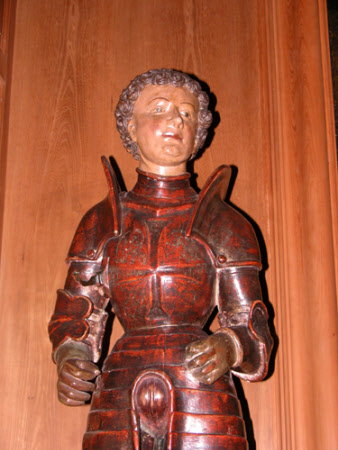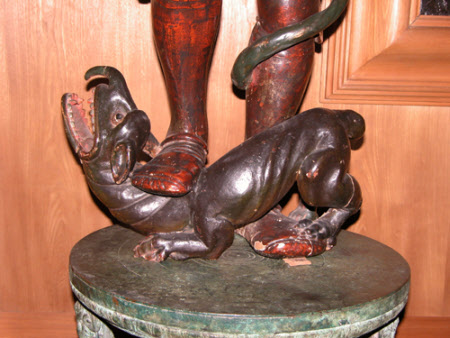St George with the Dragon
German (Swabian) School
Category
Art / Sculpture
Date
c. 1510 - 1520
Materials
Polychromed silvered and gilt wood
Measurements
102 x 36 x 21 cm
Place of origin
Swabia
Order this imageCollection
Anglesey Abbey, Cambridgeshire
NT 514507.1
Summary
Polychromed silvered and gilt wood, St George with the Dragon, a guardian figure from an altarpiece, German (Swabian) School, c. 1510-20. A South German early 16th-century wooden sculpture of Saint George, standing and looking to his left, his right foot placed upon the dragon that he has just defeated. Except for his uncovered head, he wears full armour with high pauldrons (shoulder pieces), and a rest for a jousting lance at the right side of the breastplate. An embossed Cross on the breastplate. Saint George originally held an object, probably a lance, in his right hand, and there is a hole in the middle of the left hand, suggesting this too originally held something. The sculpture made of wood, polychromed and silvered (the armour), with silver leaf applied to a red bole ground. Hands separately carved and attached, as are elements of the dragon. Right hand to wrist may be a replacement. Dragon’s front right leg is lost. The hair was probably originally gilded. The parts of the sculpture visible from the front have been restored and overpainted; there are later painted floral patterns visible on the breastplate. The sculpture and its pair, probably Saint Florian (NT 514507.2), were made as guardian figures to stand either side of the central shrine of a large wooden altarpiece in a church.
Full description
The saint depicted in this statue is George (died c. 303), a martyr saint famous as the patron saint of England, but also worshipped elsewhere in Europe, including Southern Germany and Austria. George is said to have lived in Asia Minor, today’s Turkey, and to have been born in Cappadocia and died in Lydda in Palestine, towards the end of the third century A.D. His cult reached its height during the late Middle Ages and early Renaissance period. The most famous story concerning George, his defeat of the dragon that had been terrorising the people of a country and was about to devour the daughter of the king, is not historical, but rather is largely based on the telling of the story in the Golden Legend, a collection of saints’ stories written by the Italian churchman Jacopo de Voragine (c. 1230-98), which became immensely popular in the following centuries. This monster terrorised the local area, poisoning with its breath anyone who approached it. For a time the local populace kept the dragon at bay with an offering of two sheep every day, but when there were no more sheep a human victim had to be found, the lot falling to the king’s daughter, who was sent to her fate dressed as a bride. George attacked the dragon, piercing it with his lance and subduing the animal, which he bridled using the princess’s girdle and led, as if it were tamed, before the people. George then announced that if the populace would believe in Jesus Christ and agree to be baptised, he would rid them of the monster. On the king and his people agreeing to these terms, George despatched the dragon, whilst 15,000 people were baptized. The saint refused any further reward for his service, instead asking the king to maintain churches, honour the clergy and show compassion towards the poor. The sculpture reflects the story faithfully, with the miniature dragon very much alive, indignantly subdued beneath the saint’s foot. Saint George seems originally to have been holding something in his left hand, which might have been the princess’s girdle, the other end of which would have been fastened around the dragon’s neck. The two figures of warrior saints were evidently made in the same workshop and must have once formed part of the same ensemble. Figures such as these were commonly placed in altarpieces, standing in niches and generally flanking the main image, thus functioning as guardians of the Holy figures in the main shrine in the form of sculpted figures or on painted shutters. Although standing figures made for altarpieces are often either left unworked or only summarily worked at the back, these two figures are noteworthy for the degree of finish in all areas, including the back. This is because they would almost certainly have stood on pedestals on either side of the main shrine, an arrangement that can be seen in the High Altar of the parish church of Saint Wolfgang near Salzburg, made by Michael Pacher (active c. 1465, died 1498) and his workshop, with its two magnificent standing figures of Saint George and Saint Florian between 1471-81 (Nicolò Rasmo, Michael Pacher, London 1971, figs. 82-83). The St Wolfgang Altar is one of very few Gothic altarpieces to remain intact and in its original location, so is important for showing how such figures functioned. In St Wolfgang, they stand on pilasters either side of the shrine, so that when the painted shutters of the altar are opened, the guardian figures are in fact concealed from the congregation. Like the Anglesey Abbey warrior saints, Pacher’s two saints are carved in the round, their armour meticulously described. Both of the Anglesey Abbey warrior saints would originally have held lances, matching the jousting armour they wear. The most impressive element of the figures is the remarkably accurate and detailed rendition of the armour, which is fully realised also at the backs, down to the fastening straps. The silvering of the armour would when fresh have given the figures a splendid aspect. The accurately-depicted armour helps to date the sculpture to c. 1510-20, the high vertical haute-pieces on the pauldrons (shoulder pieces) and high neck guards for example being typical of German armour from around this time. The recessing of the cross on the breastplate may be compared with the breastplate made for a Teutonic Knight around the same time, in the Rüstkammer, Dresden (Inv. M142). Similar styles of armour may be seen in the armoured figure of a knight in the drawing of A Knight and his Lady by Albrecht Dürer (1471-1528) in the Christ Church Picture Gallery, Oxford, of c. 1510 (Christopher White, Dürer. The Artist and his Drawings, second edition, Oxford 1981, pp. 132-33, no. 52) or in another drawing of a knight in armour by the Dutch artist Jan Swart in the British Museum, c. 1510-20 (inv. PD 1871,1209.2067). The figures by Michael Pacher in St Wolfgang are among the finest examples of these South German or Austrian guardian figures. Another outstanding pair is the Saints George and Florian from the dismantled altar made by the Swabian sculptor Hans Multscher (c. 1400-1467) for the parish church of Sterzing (Vitipeno) in South Tirol, now in the Multscher-Museum in Sterzing (Erich Egg, Gotik in Tirol. Die Flügelaltare, Innsbruck 1985, pp. 76-82, Abb. 34; Ulrich Söding, Hans Multscher. Der Sterzinger Altar, Bozen 1991, esp. pp. 27-29, Abb. 25-32). Like the Anglesey Abbey and St Wolfgang saints, Multscher’s figures are carved in the round, with close attention paid to the details of the accurately depicted armour. Like the Anglesey Abbey saints, they are also depicted bare-headed. Another pair of Saints George and Florian wearing full armour, made in Tirol and dated c. 1500 , is in the Skulpturensammlung of the Staatliche Museen, Berlin (Invs. 8181-82. Theodor Demmler, Staatliche Museen zu Berlin. Die Bildwerke des Deutschen Museums. III. Die Bildwerke in Holz, Stein und Ton. Grossplastik, Berlin and Leipzig 1930, pp. 279-80). The pose of the figure of Saint Florian is especially close to that of the second saint in the Anglesey Abbey pair. Yet another Tirolese pairing of George and Florian, datable to c. 1480, is in the Tiroler Landesmuseum Ferdinandeum in Innsbruck (invs. P 1008, P 1009. 1500 circa: Leonardo e Paola, una coppia diseguale; De ludo globi, il gioco del mondo; Alle soglie dell'empero, exh. cat., Schloss Bruck, Lienz; Palazzo vescovile, Bressanone; Castel Beseno, Besenello, Milan 2000, p. 193, no. 1-18-9). The identity of the saint in the companion sculpture (NT 514507.2) is less easy to decipher, but he is probably Saint Florian, the patron saint of firefighters, or perhaps Saint Eustace, the patron of hunters. The figure originally held an object in the right hand, which could well have been a jug or bucket pouring water onto a separately carved burning building, as seen in Michael Pacher’s figure of Saint Florian or in the Saint Floran in the pair in Berlin. Jeremy Warren 2020
Provenance
Acquired by Huttleston Rogers Broughton, 1st Lord Fairhaven (1896-1966), between 1932 and 1940; listed in the Anglesey Abbey inventory of 1940, p. 152, The Library, valued at £50 the pair; bequeathed to the National Trust by Lord Fairhaven in 1966 with the house and the rest of its contents.
Credit line
Anglesey Abbey, The Fairhaven Collection (National Trust)
Makers and roles
German (Swabian) School, sculptor
References
'Anglesey Abbey, Lode, Cambridgeshire. An Inventory and Valuation of Furniture, Books, Ornamental Items & Household Effects .. prepared for Insurance Purposes’, Turner, Lord and Ransom, April 1940, p. 152. Christie, Manson & Woods 1971: The National Trust, Anglesey Abbey, Cambridge. Inventory: Furniture, Textiles, Porcelain, Bronzes, Sculpture and Garden Ornaments’, 1971, p. 149. Russell 2007: Joanna Russell, ‘Anglesey Abbey Sculpture Project’, Hamilton Kerr Institute, University of Cambridge, 2007, pp. 23-27, Pl. 7, Appendix, pp. 27-31.
